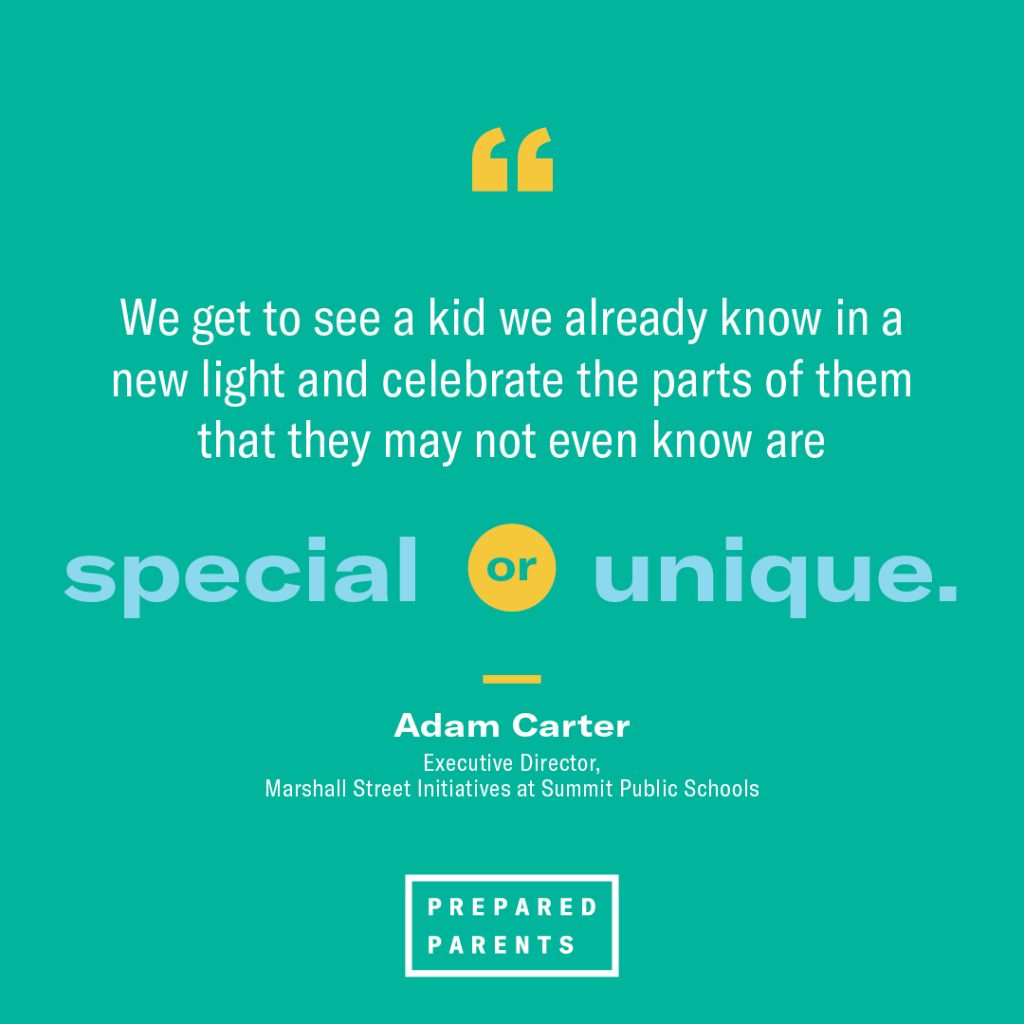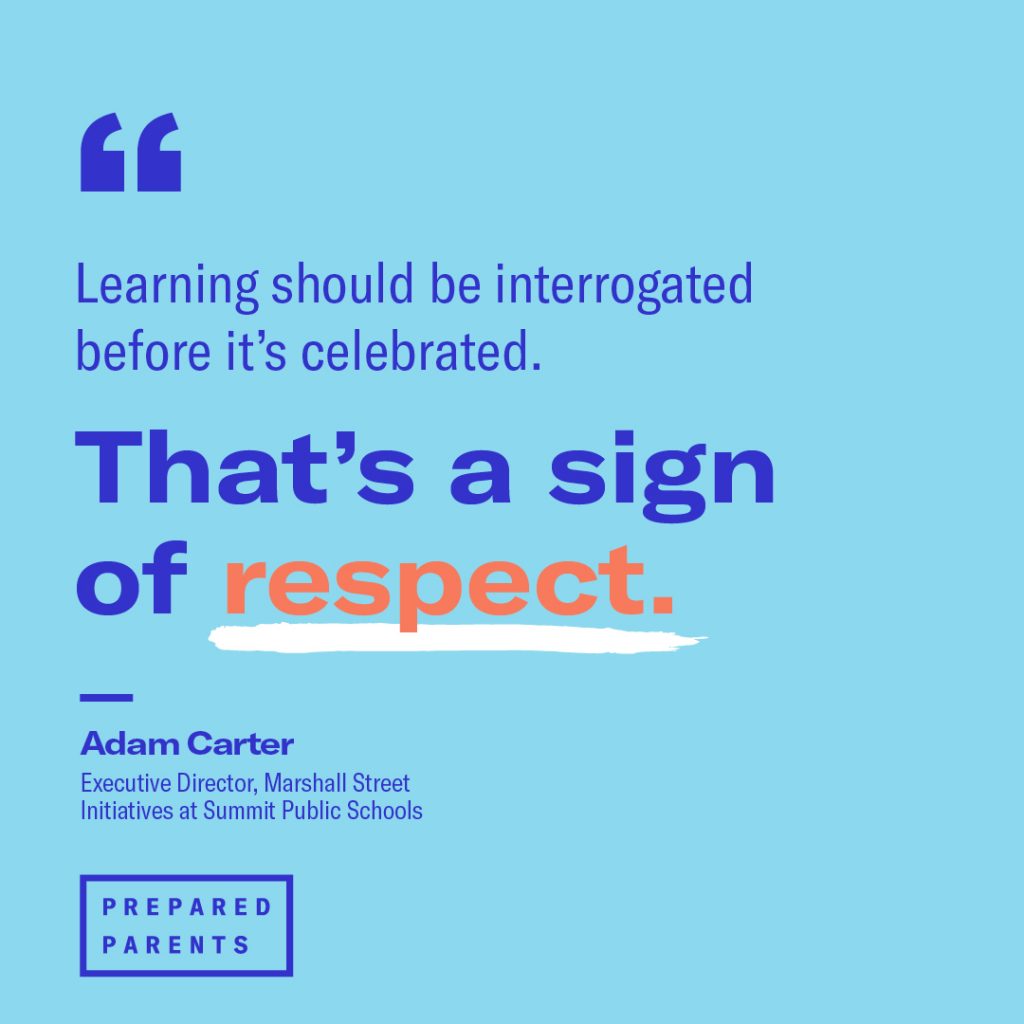When it comes to our kids’ activities, we are trained to know their performance metrics down to specifics—batting average, minutes per mile, pirouette count. But often when it comes to learning, the detail is lost. How are they advancing as learners? What’s getting them really pumped up? Where could they use extra support? A Celebration of Learning gives us the opportunity to tune in to our kid’s learning in deeper, more substantive ways.

A celebration of learning is an event that allows kids to reflect on and share their learning and growth. A celebration directly links a kid’s Habits of Success and Universal Skills with their achievements. Kids take center stage to showcase their work, feel pride in their accomplishments, and expand their comfort zone to present their work in front of others. The act of celebrating is both motivating and identity-forming for kids.
When we celebrate our kid’s learning we offer them a powerful opportunity not only to discover who they are and how they learn, but also to develop self-confidence and purpose. It also enables kids to share successes with the people who matter most in their life. Celebrations highlight the importance of community and relationships in learning, and help kids create lifetime memories around their learning experiences.
A celebration of learning has many benefits:
- It fosters a sense of belonging as a kid takes center-stage. The celebration shows how much they’re valued.
- It holds kids to high standards as they share their best work.
- It increases motivation to learn more.
- It leads to a positive sense of self-identity as a learner.
- It leads to reflection on what they have learned, how they learned it, and what skills and habits they’ve adopted to improve learning.
“My English teacher, Miss Jackson read my assignment to the class as an example of how to write an essay. It was because of this celebration of my work that I stopped thinking of myself as a kid who was just good enough to get by and started to recognize I had actual strengths and talents that could be brought to bear not just in the classroom, but ultimately beyond that environment.”
-Adam Carter, Founding Executive Director of Marshall Street Initiatives
A celebration typically includes three things:
- A final product. Something tangible each kid can present, such as a report, slideshow, art exhibit, model, or prototype. These can be from a project, the development of habits or skills, or any other big milestone in a kid’s learning.
- A presentation. A kid-led introduction to what they learned, how they learned it, and how it connects to their interests.
- Community. Friends, family, and others who have gathered (virtually or in-person) to celebrate learning.
Step 1: Give helpful feedback.
Offering helpful feedback that builds a kid’s abilities is a skill that can take time to learn—don’t beat yourself up if you’re still developing these skills! For the celebration of learning—as well as on everyday tasks— keep these principles in mind:

- Be constructive—Your goal is to build up, not simply praise. Make sure your feedback offers practical next steps.
- Be specific—When offering feedback, base your comments on facts or examples from kids’ work, goals, or reflection or on the requirements of the project or activity.
- Be careful—Make sure your comments are logical, timely, and clear, not open to misinterpretation.
- Be realistic—Emphasize process and growth, not smarts and achievement. Realistic goals should be challenging, but also achievable.
- Be sensitive—Provide constructive feedback sandwiched between statements of positivity—a 2-to-1 ratio of positive-to-negative feedback strikes a good balance.
- Be considerate—Pay attention to privacy and kids’ emotions, and be sensitive to overload.
Step 2: Ask strategic questions to help kids reflect.
Strategic questions, particularly during practice for the celebration, can also help a kid think deeply about their learning. There are two types of questions:
- Clarifying Questions: These questions are asked to better understand what a kid is saying. They relate only to the facts or the words used during their celebration presentation. You might ask a student:
- What did you mean when you said…?
- What was the goal you were trying to achieve?
- How does … relate to …?
- Probing Questions: These questions will help surface kids’ thinking so they can also do the metacognitive work of thinking about their thinking. Through this process, students further develop underlying habits such as Self-Awareness, Executive Functions, and Self-Regulation. As kids present their reflections in practice, ask questions that help them think deeply and describe their thinking. Effective probing questions:
- Are open ended and cannot be answered with a simple yes or no,
- Empower the kid to solve problems, and
- Require a kid to pause and think before answering.
Step 3: Praise the kid’s process, not their person.
During the celebration of learning, be strategic in offering praise to emphasize a kid’s process (e.g., “You looked for creative solutions”) rather than fixed personal attributes (e.g., “You’re so creative.”). This shifted emphasis contributes to a Growth Mindset.
Praise Tip #1 –
Highlight kids’ use of strategies and resourcefulness. For example, “You did a great job finding sources and digging deeper into the material.”
Praise Tip #2 –
Emphasize kids’ persistence and the joy of succeeding at challenging tasks. For example, “I know that was difficult, but you stuck with it to figure out how to make it work. Well done.” “It’s awesome that you used what you learned from unsuccessful attempts to find a way forward. That must have felt great.”
Praise Tip #3 –
The more process-related praise you can give, the better. Don’t give up on your own growth as a learning leader if you lapse into praising the person over the process. Your effort matters, and as with any skill, practice will lead to progress!
-Adapted from “Praise that Makes Learners More Resilient,” by Allison Master.

